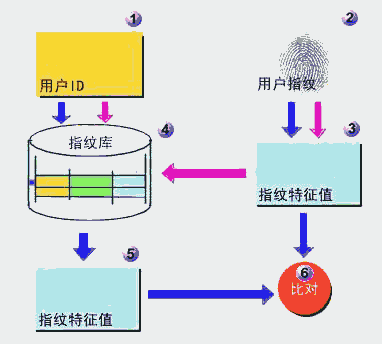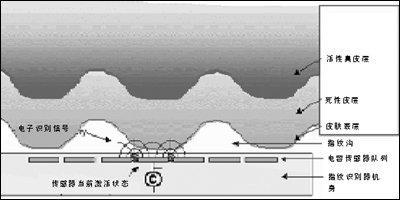
Read device fingerprint image
1. How to identify fingerprints?
Simply put, fingerprint recognition is mainly divided into four stages: reading fingerprints, extracting features, saving data, and comparison confirmation.
First, the fingerprint image is read by the reading device of the fingerprint reader. After acquiring the fingerprint image, the recognition chip performs preliminary processing on the image to make it more legible.
Next, the fingerprint recognition software establishes the "digital representation feature" data of the fingerprint and converts it from fingerprint to feature data. Two different fingerprints will produce different characteristic data.
Fingerprints are composed of multiple "ridge" -like patterns, similar to mountain ridges. Because the lines are discontinuous, the ridge-shaped pattern is diverse, such as bifurcation, arc, cross, triangle, etc. The recognition software coordinates the positioning of these ridges, and then marks the data points (Minutiae) from the coordinate positions. These data points have more than 7 unique characteristics at the same time. Because there are usually 70 nodes in a fingerprint, about 490 data will be generated by software calculation.
Different manufacturers will use different algorithms. Some algorithms combine node and direction information, and some algorithms process the entire fingerprint image. This is the strength component of each manufacturer's security technology.
Finally, through the method of fuzzy comparison, the templates of the two fingerprints are compared to calculate the similarity between them, and finally the matching result of the two fingerprints is obtained.
2. Is fingerprint recognition reliable?
People have formed fingerprints from the age of four months, and it has become one of the basic physiological and physical characteristics of everyone. The fingerprint characteristics are fairly fixed and will not change with the age of the person or changes in physical fitness. If the finger is damaged and the dermal tissue is damaged and the fingerprint is destroyed, the damaged surface will heal and recover quickly.
Each person's ten-finger fingerprint is different. Each fingerprint generally has 70-150 basic feature points. As long as there are 12-13 feature points in the two fingerprints, they can be regarded as the same fingerprint. It takes 120 years to find two identical fingerprints based on this. The human population is calculated at 6 billion, and it takes about 300 years to have duplicate fingerprints. Therefore, it is almost impossible to find two identical fingerprints.

Fingerprint features are generally divided into general features and local features. The overall characteristics include pattern, classification of feature points, direction, curvature, and position. Since each feature point has about 7 features, ten fingers have a minimum of 4,900 independently measurable features. Based on the diversity characteristics and unreproducibility of fingerprints, each fingerprint is unique. Using fingerprints for identity authentication can completely prevent the phenomenon that keys and IC cards are stolen or passwords are cracked, leading to illegal entry by others.
3. The principle of fingerprint recognition notebook
The latest second-generation fingerprint identification system uses capacitive sensor technology to create a "mountain-like" fingerprint image through weak electrical signals for fingerprint identification. Compared with the first-generation recognition system, it can more effectively prevent the use of "fingerprints" and other finger surface information to obfuscate.

The capacitive sensor of the fingerprint identification system sends out an electronic signal, which will pass through the surface of the finger and the dead skin layer and reach the living layer (dermis layer) of the finger skin directly to read the fingerprint pattern. As it penetrates deeper into the dermis layer, the sensor can capture more real data and is less susceptible to dust on the surface of the finger, improving recognition accuracy and effectively preventing recognition errors.
In daily applications, users enter fingerprint information at the beginning of the operating system installation and associate it with specific personal login information and password. After the system establishes the matching information, the fingerprint identification database becomes effective. When using a computer to log in to a personal account, users only need to swipe their finger on the fingerprint reader to easily and efficiently pass verification.
DYX mini vacuum pumps can be customized from DC3V to 24V, 0.5-16LPM flow rate and -20~ -85Kpa vacuum pressure are available.
Mini diaphragm vacuum pumps are small-sized pumps that are commonly used in various industries for their compact design, low noise, and high efficiency. These pumps are designed with a diaphragm that oscillates back and forth, creating a vacuum that can be used for various applications. These Mini Pumps are classified based on their flow rate, vacuum level, and the type of diaphragm material used in their construction. The flow rate of mini diaphragm vacuum pumps can range from a few milliliters per minute to several liters per minute. The vacuum level can range from a few millibars to several hundred millibars, depending on the pump's design and application. The type of diaphragm material used in mini diaphragm vacuum pumps is rubber. Rubber diaphragms are preferred for applications that require high durability and flexibility. Overall, mini diaphragm vacuum pumps are versatile and reliable tools that are widely used in laboratories, medical facilities, and various industrial settings. They offer a cost-effective and efficient solution for creating a vacuum in small-scale applications.
Mini Vacuum Pump,Suction Pump,Dc Mini Vacuum Pump,Vacuum Blender Micro Air Pump
Shenzhen DYX Technology Co.,Limited , https://www.dyxpump.com